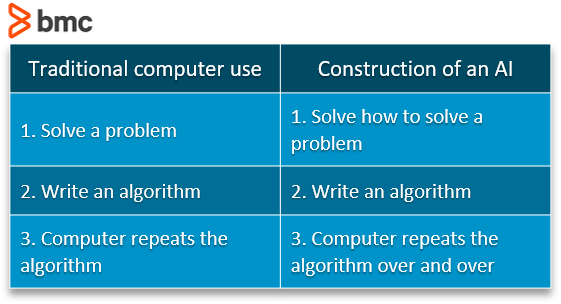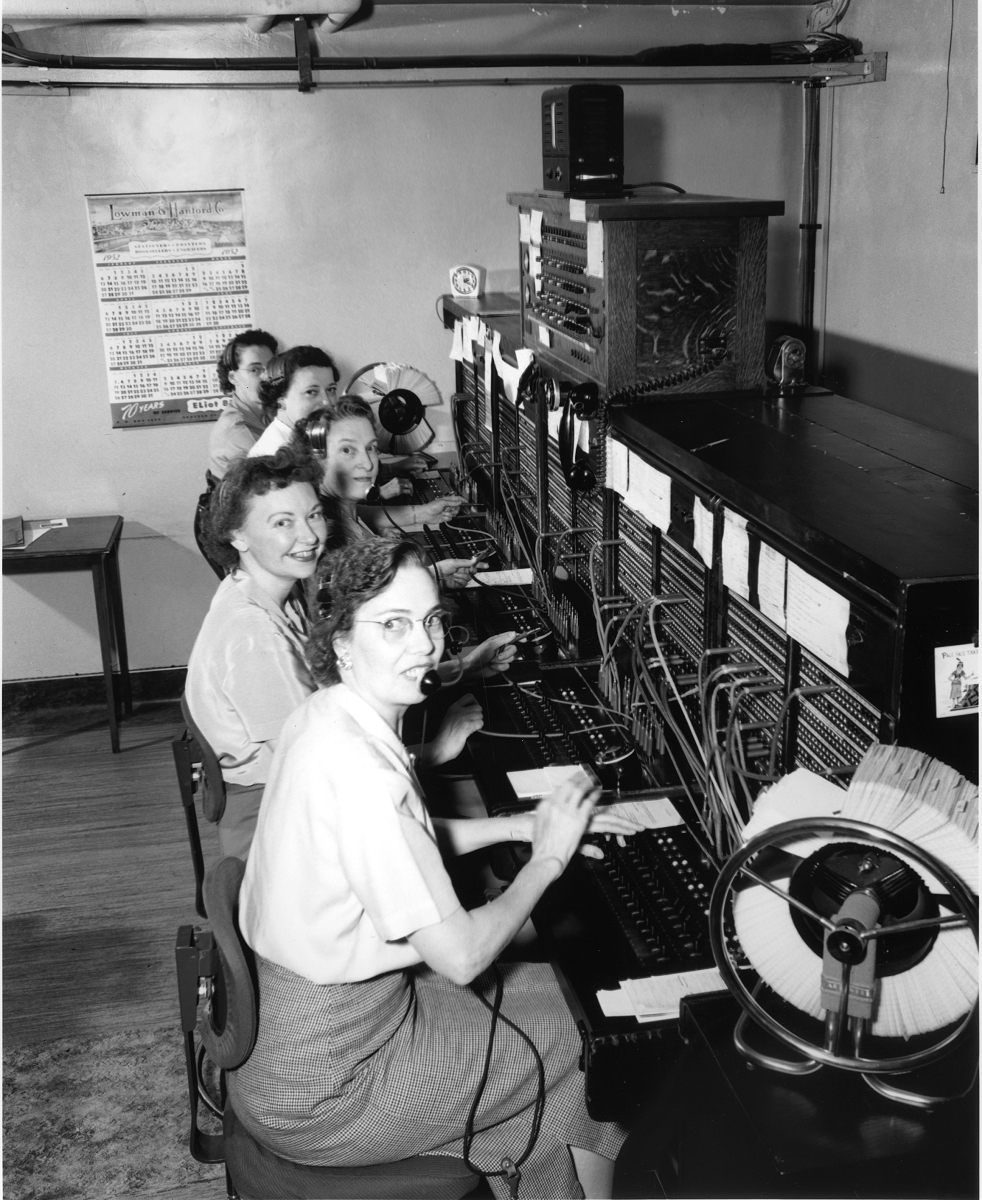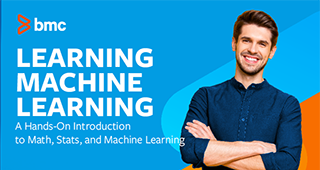Many predictions to the outcome of the humans and artificial intelligence take an either/or approach.
Skynet is determined to end the human race in The Terminator. In The Matrix, the machines have learned to farm humans for battery power. Then, there are the reports that AI beats the best Go and Chess players in the world, and there is no shot for a human victory.
These views make it seem that in order to win, humans must exist free of computer control. A more likely outcome—a better picture of success—is to say, “We found our peace through AI/human augmentation.”
AI/human augmentation is a view that sees the story of humans and machines as one of cooperation. It puts the human in the driver seat and focuses on how AI becomes assistive to enhancing human capabilities—like with hearing, seeing, and making decisions. Communication is an important factor to AI human augmentation. Communication can happen through sensors, human-in-the-loop learning, user surveys. Finally, our ability to create, detect, and communicate with these AIs, depends on how we believe they work.
AI/human augmentation is the most plausible look at the future of human computer interactions and deserves more attention.
What is human augmentation?
“Computers are like a bicycle for our minds.”–Steve Jobs
Computers were a leap in tool-building that made people far more capable than before. Computers allowed people to:
- Solve a problem once.
- Write lines of code to perform it.
- Let a computer perform the task over and over.
The development of artificial intelligence (AI) has inserted itself as a prologue to these steps in problem solving. It is in this step of human decision-making that AI is having its profound impact.
AI has allowed a developer to solve how to make a decision around the same problem. Before, when a similar problem presented itself, a developer would have to sit down and write another program to tackle this new variation in the problem. But with AI, the developer is tasked with defining the scope of the problem, and then allowing the AI to make the decision for what the outcome should be.

AI/human augmentation example
In a brief example, an engineer must meet the requirements to construct the design of a building. An engineer needs to know whether 2x6s or 2x12s can cover the span from wall to wall. If there is a second floor, can the joists support the weight of the people walking on the floor? If there is a roof load passed to the floor system, are the beams and joists large enough to support the weight passed to them?
Given the design, the engineer has options on how to best engineer the ceiling and roof system in order to:
- Cost the least amount of money in timber costs
- Continue to support the structure
If the engineer were a computer developer, however, perhaps they could create a program with a guided set of rules to engineer the house for them. The limitation in previous computer programs has been that, for each new house the engineer would build, he would have to create a new program to do the engineering of the house. Every new design will be governed by the same rules (a 2×6 can only support so much weight—its variable is constant across houses).
Here is where the AI comes into play: AI lets the engineer write a piece of software that can do the engineering for all houses instead of having to write a new one each time a new design comes across their table.
AI helps humans
When the AI is created to make decisions around common problems, and used to assist in making decisions, the relationship between person and AI actually transforms who people are.
The very things people can accomplish changes. The day-to-day activities people perform changes. People are no longer set to fixate in one domain, solving the same problem over and over. Instead, people can:
- Travel across many domains.
- Understand a domain’s problem.
- Create an AI to tackle that problem.
Benefits of AI (Does AI destroy jobs—or do we?)
In the human-AI dance, aside from human extinction, the primary concern people have is that AI is going to eliminate many jobs.
I must say, jobs have always had a lifecycle. Airline pilots used to be a top-of-society, high-end job. Banking and finance took a top spot in the ‘80s. These things change based on:
- Skill levels
- Competition
- Available technologies
Next, having old jobs persist into the future is not an appropriate standard by which to measure society.
If, suddenly, there were no more oil jobs because everyone worked at nuclear plants—because that is the energy in demand—that is not a bad thing. It is an adjustment to the times. If there were still floors of telephone switchboard operators in existence in today’s labor market, it’d be easy to wonder, “Why is that company still doing things that way?”

Instead of being concerned about AI eliminating jobs, the real questions we ask should be:
- Are there enough new jobs for people to get into?
- Are training and education easily accessible and affordable?
- Is there plenty of investment money in circulation to take risks on new industries and new ideas that lead to creating places for new workers to work?
The effect AI/human augmentation has on the market is, of course, eliminating old ones—but that is not the only thing, nor is that a bad thing.
AI helps focus people, work
AI’s entering the marketplace will also remove the remedial day-to-day tasks and let people work on the things that matter.
It can remove those parts of the workday nobody looks forward to doing. Whether it is because it is a communication hell or it is a lot of minute, detailed work, alone in a dark room which has to get done so food can be put on the table…all those things, AI is ripe to assist with!
People can use AI to eliminate the dull times, and place greater human attention on those things that matter. People can perfect their roles in certain areas. It is the elimination of simple tasks. It is more quality time spent doing the things that matter. Some will be gone, but new ones will also be created.
In photo or video editing, for instance, instead of spending hours editing a photo to include a person who was not present in the original photo, the editing can just be done by using the Photoshop technology with perfect blurring, lighting, and blending techniques. Honestly, you might not even know there is AI being used in the background.
The features and the things that you are capable of will increase—and they’ll increase in complexity. (But only for those who knew how it used to be done. Young eyes get to start with this tech and see how it transforms over time.)
The photo’s creator just has to give direction to what exactly they want. The photographer can spend more time trying to communicate their message, and less time doing the actual engineering.
AI enables people as creative curators
If an AI can fill in a lot of the processing steps, people have more time to iterate over different designs before selecting their final one.
In architecture, the design process might work similar to photos. The designers can say, we want walls here, here, and here. Then the AI, which can do all the structural engineering to ensure the building stands and passes city codes, can figure out how to construct the layout. If it is not liked, the designers can undo it, and try another variation.
In a perfect setup, people’s roles can shift from doing the grunt work to actually designing. Industries where people’s roles turn into creative curators:
- Architecture
- Painting
- Photography
- Music
- Writing
- Coding
Perfect elimination of the grunt work is a look at the ideal, but there will always be some form of new thing. As people relieve themselves from one challenging endeavor, they start using their newly freed time to push the boundaries of the new technology, ultimately creating a new problem.
Animation has been happening through various technological forms for 100+ years, and, even with computers and AI used to help, there are now more people working on a team to create an animated film than there were 100 years ago.
People as relatable entities
People are still the best at being people. This is both good and valuable. It sets the parameters around the human entity.
While machines might assist with making decisions, there still exist lots of emotional tensions, struggles, and hardships that people help each other get through. There will always be this necessary component.
Human augmentation example: AI in education
I think one opportunity where AI/human augmentation can present a clear and present shift is with teachers. I am the son of a high school teacher, and I only speak about this from the heart.
Like how an AI can make better moves across a chess board to defeat an opponent, an AI might become the best at selecting the “when and how” to dispense knowledge to educate a student. The AI could do the laborious tasks:
- Creating a curriculum
- Designing a syllabus
- Grading tests
The value of using an AI is to define the problem space and allow the AI to create many unique solutions. That means an AI can create a unique educational path for each student—which is far beyond the capabilities of any educational institution today.
The best organizational structure schools have found, thus far, is to create two or three different paths with a base-level path, then one or two accelerated path options (i.e.; AP and IB classes). More variation comes in the extracurriculars students get themselves into.
For education, this use of AI actually sounds great: Students can take a path suited to them, driven by their curiosity, and move down it at their own pace.
With AI in the mix, the teacher’s role is necessary because the presentation of new information is always met with resistance by a learner, and students handle the moment in various ways. The teacher becomes the students’ guide to instill discipline when approaching new topics. They:
- Encourage to persist through the struggle
- Act as a soundboard for feedback
And, with their lesson planning offloaded, teachers have the time to tend to this core responsibility. Teachers act as guides to knowledge acquisition, not dispensers of knowledge.
AI supports focused problem solving
The clear definition of success makes the use of AI in education possible. Papers are graded, and, by the end, the goal is to have a higher-level understanding of the maths, sciences, and the humanities.
Outside the educational world, however, once a person enters life—“the real world”—the path to success is not so clearly defined. It is not agreed upon, and it is not measured by passing grades, nor has another level of achievement.
Life is harder, maybe even impossible, to define what a “win” might be, yet we continue attempting to define the game. For example, there are paths through college, careers, family-planning, homeownership, and probably… I have lost a few people already in what qualifies as a successful path through life.
What is a successful life? This is far too broad of a problem for AI to solve. And it’s likely the wrong way of thinking about this.
Because AIs have limitations, the kinds of applications that come from AI/human augmentation are therefore limited. An AI cannot assist with broad problems like designing choices through life, but it can assist with narrow scopes like:
- Improving your grammar
- Making your choices on a chess board better
- Knowing when a person has a grasp on algebra, and what math comes next
Challenges of AI (AIs require new work)
AI presents its own challenges to operate. AI is not a perfectly running machine. It has all its own maintenance requirements.
In the new, booming AI industry, new jobs arrive that have both low-skill and high-skill labor options. The upkeep requirements to build and maintain a good AI in turn creates other jobs.

(Learn more about data annotation, technical debt & performance monitoring.)
AI/human augmentation is the step towards AGI
Artificial General Intelligence (AGI) is the holy grail of the AI world right now. AGI is built around the idea that a single AI can have the general intelligence of a human. But, because of how varied the human intellect is, and how fragmented all data collection and uses are, at present, it is infeasible to build an AGI.
The success of an AGI is dependent on:
- The number of points of contact between AI and human
- The kinds of data which passes between the two
It only makes sense, then, that AI/human augmentation is a necessary step towards building an AGI because it creates more points of contact though the apps that get created, and the data flow will continue to increase as the complexity of the interfaces increase. Whether an AGI is the goal or not, AI applications will continue to be developed to enhance human ability—which only helps the cause of AGI and makes its outcome seem certain.
- AGI requires more data to map human behaviors and decision-making.
- AI/human interfaces provide exactly this.
So, AGI is going to be built at some point. Whether there exists any fear over this depends on how you choose to grant an entity the right to communicate and engage with negotiation, and, in a similar vein, but from another angle, which devil you choose to assume exists.
The science of communication
The tech isn’t itself the problem. The blame comes down to the person designing it. An AGI isn’t necessarily bad, but, through its design, maybe it comes off as tyrannical.
Norbert Wiener is considered the originator of cybernetics, defined as the science of communication as it relates to living things and machines. The key here being communication. The communication between machines and living things has many potential states: It can exist, not exist, grow dull, be adversarial, and so much more.

(Source)
His book Human Use of Human Beings (1950) has stood the test of time, and rings with clarity today. He articulates a particular aspect of human-computer interactions which define the human, how communication occurs, and how machines learn. Furthermore, it defines the kinds of cultural visions, the goods and bads, of what should be believed in if we are to be successful in our human pursuits to live.
Wiener places limits on chaos and what the nature of that chaos should be if a scientist is to make any progress in their pursuit to understand it. This is precisely the consideration that needs to take place if people are to create a superintelligent AI. If AGI is to ever reach beyond the point of interpretability, then designers need to create aims towards making it the AI’s goal to make itself communicable and predictable so scientific judgements can be made.
In such a case, Wiener defines two kinds of opponents— ‘devils’ as he calls them—a person can face when trying to communicate. In Wiener’s view, there are the Manichaen and Augustinian devils.
- The Manichean Devil is the tricky and crafty opponent. He keeps his policy of confusion secret. If we show we are ever close to figuring out its secret, it will change its policy to keep us in the dark.
- The Augustinian Devil can be understood and does not actively try to confuse.
In communication between entities, if the result is to reach understanding and an agreement, it is the Augustinian Devil people wish to be in a game with. The intent of the AGI will be to reach some understanding. But, if the opponent is Manichaen, the two parties can never reach any kind of understanding because the Manichaen devil will actively change if it ever sees us as getting close to understanding. Wiener says, the devil the scientist faces “is the devil of confusion, not of wilful malice”.
So, the question we must ask is:
Will the AI that is created work towards an understanding (be Augustinian) or work towards mystifying and confusion (be Manichean)?
The answer people give to this question defines whether the AI and human relationship will work in harmony or with contention.
(See how people harness AI for cyberattacks.)
When is AI too far?
In an AI-assisted world, through the view of augmented AI, it is not AI or AGI which should cause fear. Likely the “willful malice” that could get baked into an AI would be built by a person, and not an outcome determined by the AI itself.
Caution, then, is not of the technology itself, but of people who do not know when to stop. The caution is about those who are trying to build the path to God. Those who wish to extend far beyond their own limitations and make the world a better place. They think they can tread on old grounds, people’s homes, and show a better way.
As much as computer technology is advancing, so too can progress be made in cultural and societal technologies so people grow an understanding for:
- Who and what they are
- How to partake in societies
- What their limits are
- Where their freedoms lie
No matter how great or successful a person, or a people, becomes, they must always operate in time. Time is the great equalizer. And, in the great song of life, as much as you think you can pull people along, and accelerate their lives and their situations, you can only rush the beat.
AGI is not the threat, but people who think their technological answer is everyone’s answer run the risk of destroying the harmonies of the song. Ensembles can gather to a new beat once multiple locations recognize where the beat should be, and more and more people dance to its pulse.
Related reading
- BMC Machine Learning & Big Data Blog
- 4 Types of Artificial Intelligence
- Data Architecture Explained: Components, Standards & Changing Architectures
- Supervised, Unsupervised & Other Machine Learning Methods
- DataOps Explained: Understand how DataOps leverages analytics to drive actionable business insights
- Data Ethics for Companies







